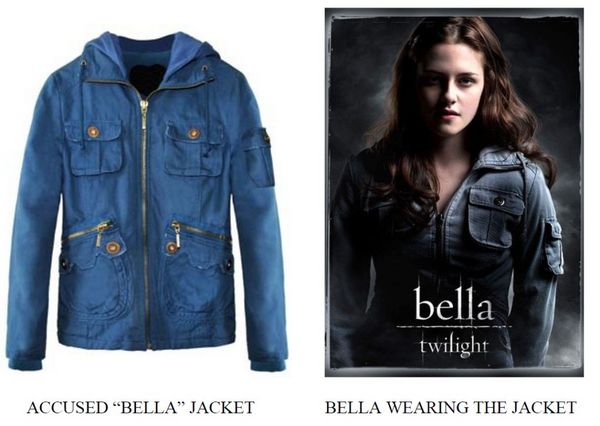Before last week’s release of Twilight Saga: Breaking Dawn Part 1, a trademark and copyright infringement lawsuit saga dawned on clothing manufacturer B.B. Dakota over the pictured Bella Jacket. Summit Entertainment, the producer of the Twilight franchise that has raked in more than $1 billion in gross revenues, owns several USPTO trademark registrations for the “TWILIGHT” and “BELLA” trademarks, including for use on clothing and jewelry. Summit of course also owns all copyrights in the movies in addition to marketing and publicity materials and the “Bella Trading Card Image.” Summit’s licensing of the intellectual property rights has grossed an additional $63 million.
Defendant BB is a clothing manufacturer that sold the pictured women’s cargo jacket in 2006 under the “Leigh” mark, which was discontinued in 2008. When the Leigh jacket was worn by Bella in the 2009 Twilight movie, BB was credited as the manufacturer in an Entertainment Weekly article accompanying a photograph. BB’s outside public relations contractor then contacted Summit’s manager of national publicity requesting permission to re-publish the EW image on its website, which she included in an email link to EW’s website. Summit’s representative responded with a simple “OK.” A few days later, BB requested permission to allow for a retail store to use the image, to which Summit responded with one word: “sure”.
Without seeking further permission, however, BB created “hangtags” for the jackets that included not the Entertainment Weekly picture, but an image of Bella wearing the jacket that Summit had used to promote posters, clothing, and other merchandise. Apparently, BB’s own PR rep warned BB to obtain permission to use the new image, but BB failed to heed the warning and argued that by including “As seen in the Twilight movie” language on the tag would constitute fair use. Thus, BB’s sales representative emailed the image to two hundred of her sales accounts representing that BB had permission to use the image on the hangtag and to publicize the product. The retailers in turn sent out email blasts using the Bella image with the belief that BB had properly licensed it. Summit sent cease and desist letters to BB’s retailers, after which BB instructed them to cut the hang tags from existing inventory and provided a substitute picture of a girl resembling the Bella character. To make matters worse, BB continued to refer to the jacket as the “Twilight jacket.”
Metropark, one of BB’s retailers, filed bankruptcy and ModCloth settled the matter. BB countersued Summit for trade dress infringement and unfair competition. Summit filed for summary judgment of liability on its trademark and copyright infringement, and trademark dilution claims and on BB’s counterclaims.
The parties did not dispute that Summit owned the Twilight trademarks. But BB claimed that its use of the trademarks constituted nominative fair use, which means that the accused party is using the trademark to refer to the other product or compare or describe its own product. A nominative fair use assertion shifts the burden to summit to negate the three elements: (1) defendant’s product or service cannot be readily identified without use of the trademark, (2) only use so much of the mark as is reasonably necessary to identify the product, and (3) defendant must do nothing that would suggest sponsorship or endorsement with the trademark owner. Toyota Motor Sales, U.S.A., Inc. v. Tabari, 610 F.3d 1171, 1182-1183 (9th Cir. 2010). Regarding the first element, the Court held that while it may have been necessary to make some reference to the movie or the person that wore the jacket, it could have been done without using the Bella image, the particular Twilight font, and certainly without renaming and marketing the jacket as “the Twilight Jacket.” As to the “reasonably necessary” prong, BB was found to have used more of the trademarks than necessary and “clearly sought to associate its product with the highly successful Twilight series to enhance its own profits.” Finally, the Court found that “the extensive use of Summit’s intellectual property at the very least implied sponsorship of the BB jacket.” Thus, the Court found that the undisputed facts established all necessary elements of Summit’s claims for trademark infringement, false designation of origin, and unfair competition.
The Court also found for Summit on its copyright infringement claim, rejecting BB’s fair use defense, license argument, and equitable estoppel defense because Summit waited several months after sending cease and desist letters before commencing suit. The Court, however, held that although all six likelihood of dilution factors weighed in Summit’s favor, a triable fact issue existed as to the “fame” of the Twilight trademark for purposes of a dilution claim and denied summary judgment on that issue.
On the other hand, the Court made short work of BB’s counterclaims for trade dress infringement and unfair competition claims: “Among the numerous reasons for which BB’s claim fails, the most intuitive is also clearest in the law. Common sense dictates that BB cannot sue Summit for appropriating or trading off that which Summit has created. This proposition is reflected in the case law holding that secondary meaning – a necessary element of a trade dress claim – must exist prior to the defendant’s use of the alleged trade dress.” This is especially true because BB had discontinued sales of the jacket before it appeared in the movie.
The case is Summit Entertainment, LLC, v. B.B. Dakota, Inc., CV10-4328 GAF (C.D. Cal. 2010).
 Los Angeles Intellectual Property Trademark Attorney Blog
Los Angeles Intellectual Property Trademark Attorney Blog


